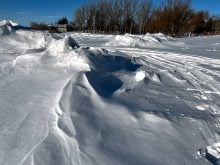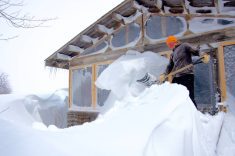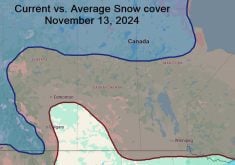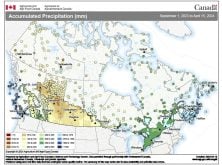A couple of articles ago I wrote about when we should normally expect winter to begin. With most areas seeing very little snow so far this year, I thought now might be a good time to look at snowfall probabilities. Just how much snow can we typically expect with each snowfall? Is the little snow we have received so far this winter surprising… or reasonably normal? Most of us, including me, expect to see several large snowfalls during the winter, but when you actually look at the numbers, it seems most of our snow comes in little bits here and there.
Read Also

June brings drought relief to western Prairies
Farmers on the Canadian Prairies saw more rain in June than they did earlier in the 2025 growing season
A long time ago, in what seems like a different lifetime, I was looking at stream flows in hydrology class and learned how to calculate the probability of 25-, 50- and 100-year floods. Once I knew how to do this, I began applying the same techniques to snowstorms and how often we should expect big storms to hit us. I went through all the snow data for Winnipeg (a nice central region) and applied the same probability techniques I learned for stream flooding, since the statistical theory is sound for both. Well, good thing I kept all that old data — let’s dig into the numbers and see what we come up with.
Before we begin, I think I should point out that when we look at snowfall data there are different periods in which you can measure snowfall, or any precipitation for that matter. You can measure the amount of snow that falls in one day, which would be from midnight to midnight. This one is easy enough, since this is the way precipitation amounts are recorded. That being said, we all know Mother Nature does not have a very accurate clock, so we can’t always count on a snowfall occurring nicely during this one-day period. Another way to measure snowfall is to calculate how much fell within a given 24-hour period. To determine this, you need access to hourly data, which, unfortunately, is not readily available. A third way we can measure snowfall, which does help us to “catch” these 24-hour-period snowfalls, is to look at what I call a “snow event.” A snow event is when we record snowfall amounts on two or more consecutive days.
Precipitation probability
Let’s begin our look by examining snowfall days. In Winnipeg, during any given winter, there is a 90 per cent chance that there will be about 30 days when snow falls. About 50 per cent of the time we will see around 45 snowfall days and there is less than a one-in-100 chance of seeing more than 70 snowfall days in any given winter. Keep in mind that a snowfall day is any day that records snow, no matter how small. Now, when we look at how much snow we can expect to fall during a snowfall day we find that 90 per cent of the time, we can expect 0.2 cm of snow or more. About 50 per cent of the time we can expect more than two cm of snow, which means about half the time it snows, we see less than two cm of snow! If we look at how often we should expect five cm or more, the probability falls to about 10 per cent. This means that if we get 30 snowfall days during the winter, only about three of them will give us more than five cm of snow. Looking at higher one-day snowfall amounts, we find 10 cm or more occurs about once in every 25 snowfall days or once, maybe twice per winter. Getting more than 30 cm of snow in one day is extremely rare. The probability of this occurring is about 0.1 per cent, which means only about one in every 1,000 snowfall days — or around once every 20 to 40 years — should we expect to see this much snow in a single day!
Now, as I pointed out earlier, Mother Nature rarely dumps all the snow conveniently during a midnight-to-midnight 24-hour period, so let’s look at snowfall events and see how the numbers shape up.
In any given winter we typically see about 20 snowfall events where we record snowfall on two or more consecutive days. About half the time we could see as many as 28 snowfall events, and once in every 100 winters we could experience as many as 40 snowfall events. As with the one-day snowfall amounts, the majority of these snowfall events only record small amounts of snow. About 90 per cent of the time we would expect to see 0.5 cm or more snowfall and about 50 per cent of the time we would expect to see more than two cm. Interestingly, these numbers are just about the same as for the one-day snowfall probabilities. If we look at the probability of receiving more than five cm of snow during a snowfall event, we would see that it happens about 30 per cent of the time. Going up to 10 cm or more, our probability drops to about 10 per cent, or around twice per winter. How often should we expect to see big storms with more than 30 cm of snow? Well, according to my probabilities, it would be about one in every 200 snowfall events, or about once every 10 years.
We do have to remember that probabilities are just that: probabilities. This means we could see much more or much less than what these numbers indicate in any one winter. So, even though snowfall has been light so far this winter, it does not mean we are due for a big snowfall, nor that the light snowfall will continue. Remember, it only takes one big storm to bring a winter’s worth of snow.




















